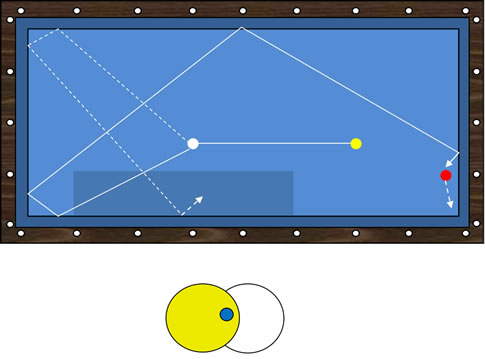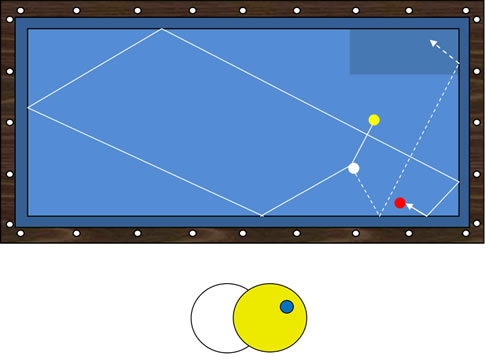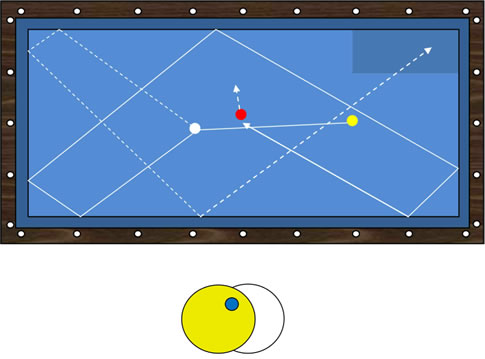Sometimes 3 Cushions is Not the Best Choice!
When you play shots three rails across the width, you must also be more accurate about which side of the second ball you score upon. It sounds like splitting hairs, but it's absolutely mandatory for good position play. In addition, you'll need a more delicate touch to control the first ball and speed of the cue ball. By contrast, playing shots over the length of the table lets you cut the first ball to a cor ner; or three rails around the table to a long-rail zone; or the other 3-rail object-ball route, short rail, long rail, short rail, to a zone; or to the short cushion and then down to a corner, in the manner of a straight-back bank in pool. Your position possibilities are far more numerous with this length-of-the-table concept.
Now on to some examples, In Diagram 1, we see a shot which comes up often. Most players will drive the first ball to the short rail, and play the shot off the obvious three cushions. This technique figures to hit the red ball full and drive it away from the corner instead of into it for good posi tion; once again, remember that ob ject balls are their biggest when near a corner. This shot is correctly played off four cushions (scoring off the end rail, as shown), over-cutting that first ball into the right-hand cor ner so it returns to the opposite side rail. The four-cushion execution demands a slightly better hit, but with the right technique specifically, two tips of 3 o'clock English and a short stroke itís really not that difficult. Most importantly, it will yield a far better second shot, all three balls near that side rail.
Diagram 3
For instance, in Diagram 4, we have the same cue-ball position, but the third-rail contact point is the corner, or four more diamonds away (assume the balls lie so there is no conventional "tickey" available). So use two tips of 7 o'clock English, to make the cue ball curve a little more than in Diagram 3 (remember, two tips of reverse English means four diamonds farther down the rail). Remember to keep your line of aim at 45 degrees through the first rail. It will probably look severe to you, the first few times you line up shots like this, but trust me: it works. (Actually, position would be possible here, too, with appropriate speed; you'd be keeping the white ball somewhere near the rail and scoring softly enough on the red that you could play your next shot off it. But let's not get ahead of ourselves; as stated, these are difficult shots in and of themselves, and besides, you've got a new system to learn here.) I've got a good idea what you're thinking:
Diagram 4
Diagrams 4 and 5 show shots similar in concept and in practice; in each case, the ball upon which you're trying to score is near the middle of the table. The correct method for shots like these is to land on that scoring ball softly, so it becomes the first ball for your next shot. (But you don't want to try and drive the ball on which you score to the center of the table; that's too far to send it, and will require you to over-hit the cue ball. shot. Don't be con fused by these explanations; once you practice my recommendations at the table, their simplicity will be apparent to you.) Also, you'll need to pay more attention to the first-ball speed if you want a good next shot.
Practice the shot of Diagram 4 by focusing on the route of that first ball: three rails into the corner, as you see. Use two tips of 3 o'clock English; your correct tem po and speed for the cue ball will come soon enough. (If you use sufficient speed to drive the first ball three rails, you should have automatically enough to score too.)
In the shot in Diagram 5, you're trying to bank that first ball softly cross-corner as a one-pocket player would; use extreme 3 o'clock English again, and add a short stroke to help retard the first ball's progress.
Note that the shots of both Diagrams 4 and 5 could be scored off three rails but, you'd be turning the first object ball loose to create multiple kiss risks, and you'd have totally uncertain position in each case. These correct-shot ideas I'm sharing with you have been gleaned by playing and observing the top players in the world. Competitive pressure will make the average player overlook these position opportunities, and nervously hurry the shot. Don't fall for that. Study these shots, look for similar concepts (they come up more often than you might suspect), and take your time. It'll pay off handsomely.
Archives
USBA Members Benefit!
USBA members receive a $50 credit on all One Day 3 Cushion Classes and a $125 credit on all Two Day Classes. Interested in becoming
a USBA member? Enroll today at
USBA.net
Diagram 1
YES, THE GREAT game's name is indeed three-cushion billiards. But, that doesn't mean that three-cushion shots are always the correct shots. The objective of these position lessons is to simplify things. But there are many, many ways to accomplish this that don't reduce the number of cushions used. I con¨stantly see average players choose such shots, across the width of the table, in¨stead of correct four or five rail shots along the length. And often enough, the longer shots will afford greater op-portunities to position object balls in high-percentage scoring zones (in the corners being the most favorable, with your second choice being along the side rails)..
In Diagram 3, we have a shot which will be played three rails by some and five rails by most. Where they misplay is made, is in trying to drive the first ball off three cushions rails (A, B & C) and back to the long rail for posi¨tion. This creates a kiss between the third and fourth cushions. Instead, bank that first ball softly cross-corner as shown. There's absolutely no chance of a kiss that way and you can see that if you score off five cushions, you'll have a juicy second shot. Here you must play more precisely for the tem¨po and speed of the cue and first balls. Use moderate (one tip) English.
© Copyright Mr 3 Cushion.com All Rights Reserved.
Diagram 2 shows you another shot which is often played, in effect, backwards. Many players will indeed choose a four-rail route. But, this choice sends the cue ball off the short rail and in behind the second ball. This knocks the red away from the corner instead of into it. These players apparently feel the angle is more natural that way. That's fine if you need only one point to win the game, but it won't get you that good second-shot position. The correct way to play this shot is off four cushions but short, as shown. The fourth rail should be the side rail. You drive the 1st object ball as diagrammed while moving the second ball toward the corner. Stroke the cue ball dead center; that will help shorten your angle.










